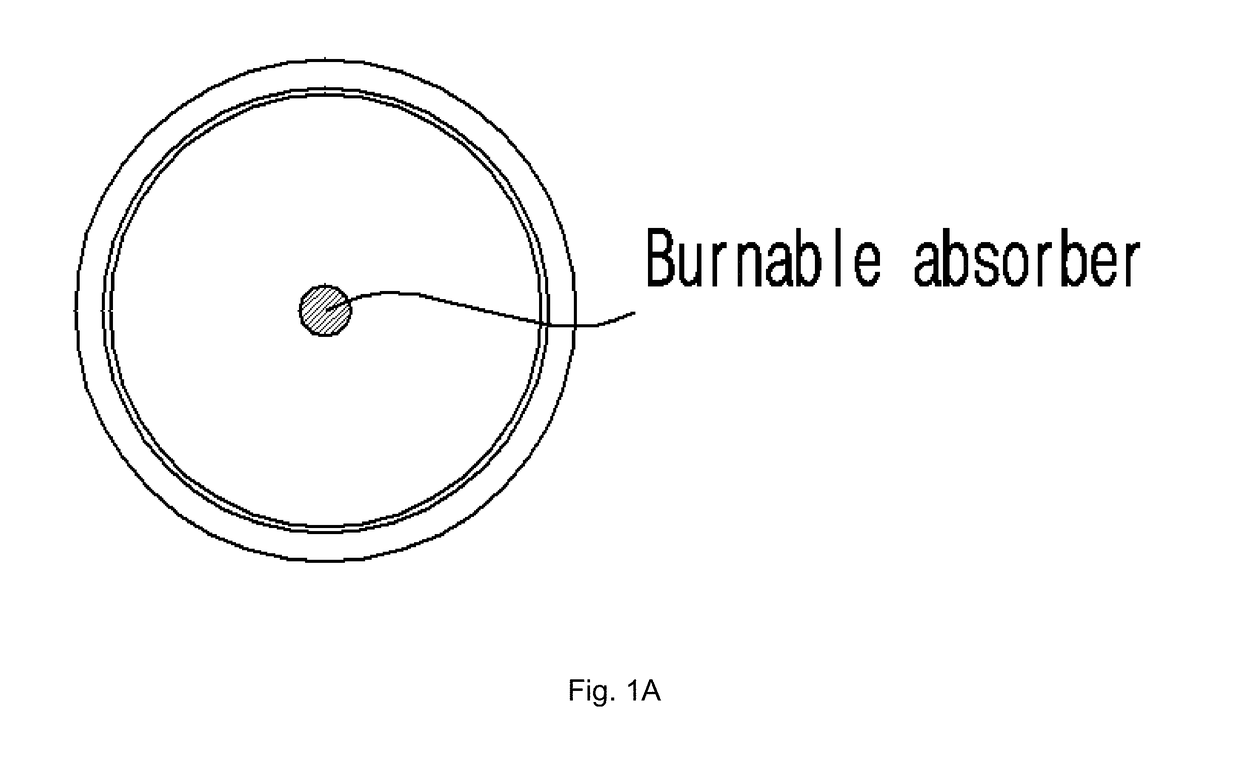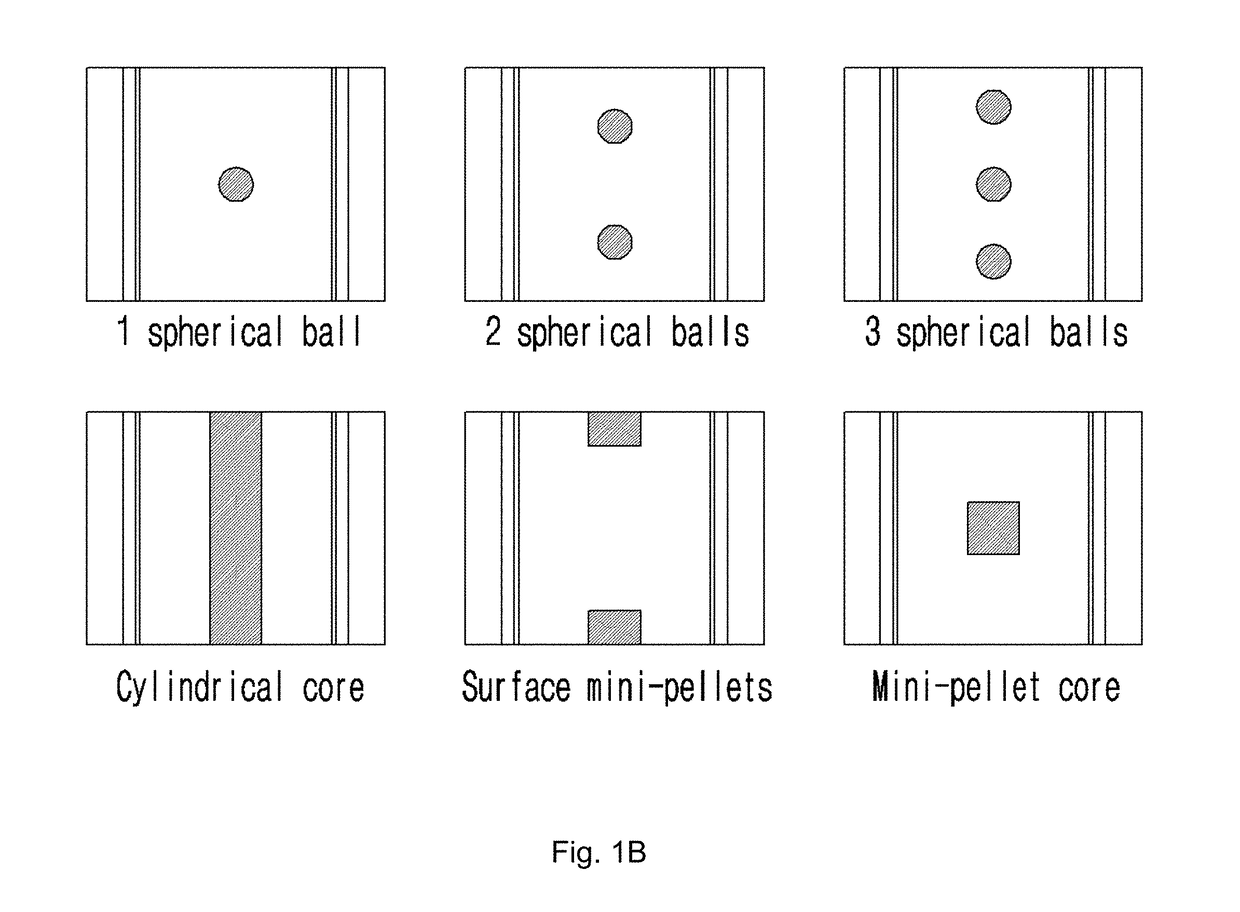Sintered nuclear fuel pellet and manufacturing method thereof
a nuclear fuel pellet and manufacturing method technology, applied in the direction of nuclear elements, greenhouse gas reduction, reactor fuel susbtance, etc., can solve the problems of increasing the risk of accident, increasing the uncertainty of controlling the reactivity, and reducing the excess reactivity of the nuclear reactor. , to achieve the effect of optimizing the performance of the nuclear fuel, maximizing fuel efficiency, and reducing the excess reactivity of the nuclear reactor
- Summary
- Abstract
- Description
- Claims
- Application Information
AI Technical Summary
Benefits of technology
Problems solved by technology
Method used
Image
Examples
example 1
[0076]The effect of CSBA on the commercial core was tested through computerized calculation. For the test, a nuclear fuel assembly model used in Westinghouse AP1000 core was considered. CSBA presented in FIG. 1 B was compared with IFBA generally used for AP1000 model. The results are shown in FIG. 2.
[0077]As shown in FIG. 2, better excess reactivity control than IFBA was possible through the optimization of CSBA, and CSBA could be optimized for core design.
[0078]The present invention provides a sintered nuclear fuel pellet that can regulate the excess reactivity in nuclear fuel efficiently by regulating the shape, the size, and the insertion location of the consolidated body of the burnable absorber.
[0079]According to a preferred embodiment of the present invention, the sintered nuclear fuel pellet can include the consolidated body of the burnable absorber inserted therein. The consolidated body of the burnable absorber is prepared by bulk-processing of the burnable absorber; displa...
example 2
(1) Preparation of Consolidated Body
[0116]The mixed powders of ZrO2-8 mol. % Y2O3(Sigma Aldrich. 99.9%, 8YSZ) and Gd2O3(Sigma Aldrich. 99.9%, 2O3, Gd2O3-5 wt % 8YSZ, Gd2O3-10 wt % 8YSZ, Gd2O3-20 wt % 8YSZ, Gd2O3-30 wt % 8YSZ, and Gd2O3-40 wt % 8YSZ pellets were obtained.
(2) Preparation of Sintered Body
[0117]The obtained pellets were sintered in a microwave sintering apparatus at 1400□, 1500□, and 1600□ for 20 minutes each. As a result, Gd2O3-5 wt % 8YSZ, Gd2O3-10 wt % 8YSZ, Gd2O3-20 wt % 8YSZ, Gd2O3-30 wt % 8YSZ, and Gd2O3-40 wt % 8YSZ sintered bodies were obtained. The XRD patterns of those sintered bodies were measured and shown in FIG. 8.
[0118]As shown in FIG. 8, when yttria-stabilized zirconia was added to gadolinia at the concentration of 5 wt %˜40 wt %, gadolinia was stabilized in a cubic phase from the concentration of 10 wt %. Since the phase change does not occur on the cubic phase to the monoclinic phase during sintering, the soundness of the sintered body can be improved
example 3
[0119]Gd2O3(Sigma Aldrich. 99.9%, 2O3 particles was hundreds □m˜several mm. The mixed powders of the assembled Gd2O3 particles and ZrO2-8 mol. % Y2O3(Sigma Aldrich. 99.9%, 8YSZ) were pressurized at 33.5 MPa, and then CIP was performed at 400 MPa. As a result, Gd2O3, 30 wt % Gd2O3-70 wt % 8YSZ, and 50 wt % Gd2O3-50 wt % 8YSZ pellets were obtained.
[0120]The pellets and ZrO2-8 mol. % Y2O3(Sigma Aldrich. 99.9%, 8YSZ) were placed in a mold, pressurized at 33.5 MPa, and then CIP was performed at 400 MPa. As a result, the nuclear fuel-consolidated body composite with the Gd2O3, 30 wt % Gd2O3-70 wt % 8YSZ, and 50 wt % Gd2O3-50 wt % 8YSZ pellets inserted into the core was prepared. The nuclear fuel-consolidated body composite was sintered in a microwave sintering apparatus at 1600□ for 20 minutes to prepare the sintered nuclear fuel pellet. The SEM images of the prepared sintered body are shown in FIG. 9.
[0121]As shown in FIG. 9, it was confirmed that the sintered nuclear fuel pellet with th...
PUM
| Property | Measurement | Unit |
|---|---|---|
| volume fraction | aaaaa | aaaaa |
| volume fraction | aaaaa | aaaaa |
| pressure | aaaaa | aaaaa |
Abstract
Description
Claims
Application Information
 Login to View More
Login to View More - R&D
- Intellectual Property
- Life Sciences
- Materials
- Tech Scout
- Unparalleled Data Quality
- Higher Quality Content
- 60% Fewer Hallucinations
Browse by: Latest US Patents, China's latest patents, Technical Efficacy Thesaurus, Application Domain, Technology Topic, Popular Technical Reports.
© 2025 PatSnap. All rights reserved.Legal|Privacy policy|Modern Slavery Act Transparency Statement|Sitemap|About US| Contact US: help@patsnap.com



